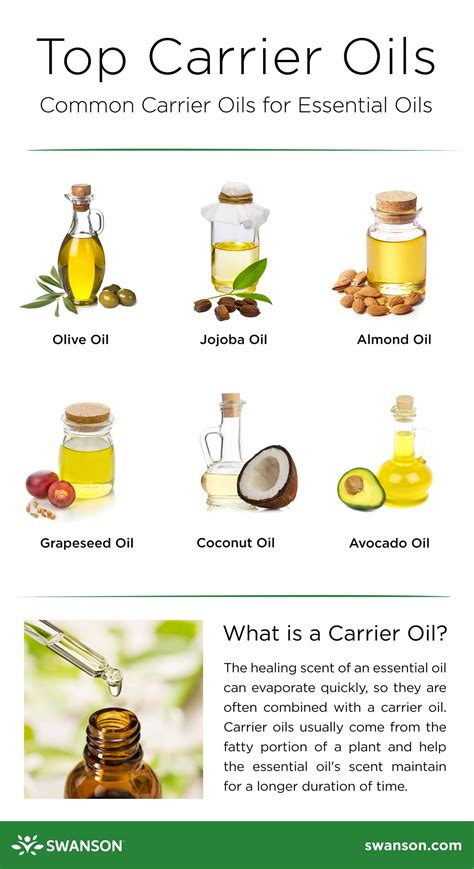Mixing essential oils with carrier oils is a safe and effective way to enjoy the benefits of aromatherapy. Carrier oils help to dilute essential oils, making them less potent and easier to apply to the skin. They also help to extend the lifespan of essential oils, making them last longer.

There are many different types of carrier oils available, each with its own unique properties. Some of the most popular carrier oils include:
- Jojoba oil: Jojoba oil is a plant-based oil that is very similar to the sebum that is produced by the skin. It is non-comedogenic, meaning that it will not clog pores, and it is also very moisturizing.
- Coconut oil: Coconut oil is a solid oil at room temperature, but it melts when applied to the skin. It is very moisturizing and has antibacterial and antifungal properties.
- Sweet almond oil: Sweet almond oil is a light, non-greasy oil that is easily absorbed by the skin. It is very nourishing and has a mild, nutty scent.
- Avocado oil: Avocado oil is a thick, rich oil that is very moisturizing. It is also rich in vitamins A, D, and E.
- Grapeseed oil: Grapeseed oil is a light, non-greasy oil that is high in antioxidants. It is very nourishing and has a mild, nutty scent.
When choosing a carrier oil, it is important to consider the following factors:
- Skin type: Some carrier oils are more suitable for certain skin types than others. For example, jojoba oil is a good choice for oily skin, while coconut oil is a good choice for dry skin.
- Desired benefits: Different carrier oils have different properties. For example, jojoba oil is good for moisturizing the skin, while coconut oil has antibacterial and antifungal properties.
- Personal preference: Some carrier oils have a stronger scent than others. It is important to choose a carrier oil that you find pleasant to use.
How to Mix Carrier Oils with Essential Oils
Mixing carrier oils with essential oils is a simple process. To mix carrier oils with essential oils, follow these steps:
- Choose a carrier oil and an essential oil.
- Measure out the desired amount of carrier oil and essential oil.
- Add the essential oil to the carrier oil.
- Stir the mixture until well combined.
The ratio of carrier oil to essential oil will vary depending on the desired potency of the mixture. For a general guideline, use 1 drop of essential oil for every 5-10 mL of carrier oil.
Using Carrier Oils with Essential Oils
There are many different ways to use carrier oils with essential oils. Some of the most popular methods include:
- Applying to the skin: Carrier oils can be applied to the skin directly. This is a good way to use carrier oils for moisturizing, massage, or aromatherapy.
- Adding to a bath: Carrier oils can be added to a bath to create a relaxing and aromatic experience.
- Using in a diffuser: Carrier oils can be added to a diffuser to diffuse essential oils into the air. This is a good way to enjoy the benefits of essential oils without applying them to the skin.
6 FAQs About Carrier Oils for Essential Oils
- What are carrier oils?
Carrier oils are plant-based oils that are used to dilute essential oils. They help to make essential oils less potent and easier to apply to the skin. They also help to extend the lifespan of essential oils.
- What are the benefits of using carrier oils with essential oils?
Carrier oils help to dilute essential oils, making them less potent and easier to apply to the skin. They also help to extend the lifespan of essential oils.
- What are the different types of carrier oils?
There are many different types of carrier oils available, each with its own unique properties. Some of the most popular carrier oils include jojoba oil, coconut oil, sweet almond oil, avocado oil, and grapeseed oil.
- How do I choose the right carrier oil?
When choosing a carrier oil, it is important to consider the following factors:
* **Skin type:** Some carrier oils are more suitable for certain skin types than others. For example, jojoba oil is a good choice for oily skin, while coconut oil is a good choice for dry skin.
* **Desired benefits:** Different carrier oils have different properties. For example, jojoba oil is good for moisturizing the skin, while coconut oil has antibacterial and antifungal properties.
* **Personal preference:** Some carrier oils have a stronger scent than others. It is important to choose a carrier oil that you find pleasant to use.
- How do I mix carrier oils with essential oils?
Mixing carrier oils with essential oils is a simple process. To mix carrier oils with essential oils, follow these steps:
1. Choose a carrier oil and an essential oil.
2. Measure out the desired amount of carrier oil and essential oil.
3. Add the essential oil to the carrier oil.
4. Stir the mixture until well combined.
- How do I use carrier oils with essential oils?
There are many different ways to use carrier oils with essential oils. Some of the most popular methods include:
* **Applying to the skin:** Carrier oils can be applied to the skin directly. This is a good way to use carrier oils for moisturizing, massage, or aromatherapy.
* **Adding to a bath:** Carrier oils can be added to a bath to create a relaxing and aromatic experience.
* **Using in a diffuser:** Carrier oils can be added to a diffuser to diffuse essential oils into the air. This is a good way to enjoy the benefits of essential oils without applying them to the skin.
